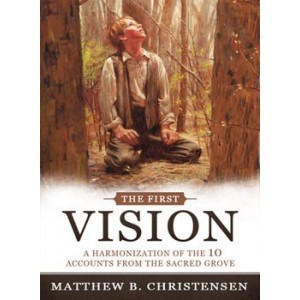 A Review of: Matthew B. Christensen, The First Vision: A Harmonization of 10 Accounts from the Sacred Grove (Springville, Utah: Cedar Fort Inc., 2014). 51 pp., no index. $11.99, FairMormon Bookstore price (reg. retail price: $14.99).
A Review of: Matthew B. Christensen, The First Vision: A Harmonization of 10 Accounts from the Sacred Grove (Springville, Utah: Cedar Fort Inc., 2014). 51 pp., no index. $11.99, FairMormon Bookstore price (reg. retail price: $14.99).
The First Vision: A Harmonization of 10 Accounts from the Sacred Grove is a small little book, richly illustrated, which provides even the most diligent students of the vision with a fresh and rewarding experience. Boasting a back dust jacket endorsement from none other than Richard Bushman—the dean of Joseph Smith scholars in the early 21st century—this small, stylishly designed book is, in my opinion, the best way to introduce Latter-day Saints to the various accounts of Joseph Smith’s First Vision.
Christensen begins with an introduction wherein he explains himself and what he is doing. Christensen is wholly aware that he is not following the conventions of historical scholarship, and is clear that what he produces is not intended to be taken as an actual historical document, or be treated like the reconstruction of an event that a professional historian might produce. Instead, Christensen is producing a tool for the faithful to use in getting closer to the founding vision upon which their faith is rooted; to help them get a fuller and more complete view of what Joseph Smith experienced. Christensen also introduces and gives some background of each of the 10 accounts he used (5 first-hand, 5 second-hand, all from Joseph Smith’s lifetime).
After the introduction comes Christensen’s “harmonization.” Here, Christensen takes the 10 accounts he introduced earlier and produces and amalgamated account, incorporating parts of all 10 accounts into one synthesized whole. Christensen smooth’s out each account, updating grammar and punctuation, and substitutes first-person pronouns when using second-hand accounts, for the purpose of readability, especially for his target audience of lay Latter-day Saints. He also color-codes the text, with a key at the bottom of each page, so the reader can easily and quickly see which account any given portion comes from. Lest one mistakenly think that by doing all this Christensen obscures the differences the accounts contain, it should be noted that he often uses the footnotes to mention and discuss some of the key differences in the various accounts.
Being familiar with the different accounts, I found many of Christensen’s choices interesting. I couldn’t help but think about how I might have merged the accounts differently. Sometimes Christensen seemed so determined to include as much as possible that the account begins to feel redundant, and I often felt that some things could have been left out. To his credit, however, there were some cases where I felt his insistence on pulling together all 10 accounts was very rewarding. In particular, the recounting of the Father’s and Son’s appearance—the vision proper—I felt was very well put together, with Christensen adeptly piecing parts of each account together in a way the vastly enriched the traditional description of there appearance in a pillar of light. He also skillfully wove together every word attributed to the divine visitors in the various accounts, thus providing a full and complete picture of the message given to Joseph Smith that day, as he understood and related it to others.
There are also some places where Christensen omits things that I would have included. For instance, I was disappointed that Christensen didn’t include Joseph’s explanation, found in the 1832 account, that his search began “at about the age of twelve years,” and continued, “from the age of twelve years to fifteen.” Few people realize that Joseph spent years searching and pondering before he had his vision, and I think getting a sense for how long Joseph was grappling with his deep questions is important for better understanding, relating to, and learning from Joseph Smith and his visionary experience. Including these age markers thus could have improved Christensen’s synthesis of the accounts.
On balance, however, I thought Christensen did a nice job, and that the account which emerges serves to enrich the experience for the reader, making it possible to better grasp the fullness of Joseph’s experience. I would recommend it as an ideal way to get introduced to the various accounts of the First Vision, particularly for parents with adolescents, who I believe should be introduced to the different accounts and other historical issues in settings and formats that foster faith. Beyond that, I would heartily recommend this little volume to Latter-day Saints wanting to get a new and fresh perspective on the First Vision—which should be all of them.
